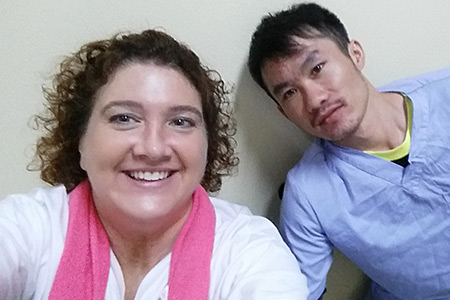Sep. 15, 2016
 A lack of access to quality patient care for children in Laos leads many families to not seek out medical care until their sick or injured child is in such poor condition that it may be too late for treatment. This is largely because there are only two pediatric hospitals in the country. Unfortunately, medical professionals at the provincial hospitals are not trained or equipped to handle surgeries or extensive care for very young children and infants.
A lack of access to quality patient care for children in Laos leads many families to not seek out medical care until their sick or injured child is in such poor condition that it may be too late for treatment. This is largely because there are only two pediatric hospitals in the country. Unfortunately, medical professionals at the provincial hospitals are not trained or equipped to handle surgeries or extensive care for very young children and infants.
Families have to travel great distances by foot, bicycle or motorbike to have their little ones treated at one of the facilities. Although children 15 years old and younger receive free medical care at Laos Friends Hospital for Children, it’s a huge financial burden for these families not to work while tending to their young ones.
They often wait several days or weeks before traveling the distance to come to the hospital, sometimes even waiting several hours just to be seen once they arrive. The financial loss and the hardship of seeking medical care are two reasons kids who arrive at the hospital often have advanced illness or severe injuries. If there were more facilities and more trained R.T.s, more children could be treated throughout the country.
Increasing the number of trained technologists is what sent me to work at Laos Friends Hospital for Children in Luang Prabang, Laos, this summer. As a Watson R.T. Community Outreach Fellow in partnership with RAD-AID International, I worked to advance sonography practices there. The Foundation and RAD-AID are committed to helping educate and train medical imaging professionals at this hospital as there is little to no imaging education in the entire country.
Drawing on my experience as an educator here in the United States, I worked with RAD-AID to develop a curriculum for training R.T.s in Laos on how to safely use sonography in their treatments. When I arrived in Luang Prabang, I set to work training a technologist who had completed radiography training and was beginning to perform sonography procedures but was in need of more instruction.
After my initial discussion with him, I adjusted the curriculum to meet the needs of the hospital based on the types of examinations that were common. I also made adjustments to accommodate his way of learning. I taught him many new things about sonography through detailed PowerPoint presentations, which I left at the hospital as a resource, and through hands-on learning with patients. He was eager to learn and quickly picked up on what I was teaching him.
Toward the end of my time there, we worked on training others in some of the basics of ultrasound. I let him take the lead so that he could gain experience teaching others what I had taught him, only stepping in when something was not being understood. I wanted to ensure the he would be a good resource for other R.T.s who would be learning sonography in the future. It was a beneficial endeavor as it increased his confidence in sharing his knowledge with others and also allowed me to fill in a few knowledge gaps for him along the way.
The knowledge and skills I helped teach and hone will be present in Laos for years to come and will continue to have a positive impact in the area. This information will continue to spread through the health care system there and will increase the availability of these procedures for many generations. It will give hundreds, even thousands, of people a future they would not have had if they were not able to seek and obtain treatment for their illnesses and injuries.
Saying thank you to the donors who made this important outreach work possible doesn’t seem like enough. There is no price, no monetary value, that can be placed on the face of a beautiful child who is healing and beginning to thrive — who, without our help, would likely have not lived to see another birthday. When these children look into your face with their big eyes and heart-melting smiles, all you can do is allow yourself to be overwhelmed with a grateful attitude.
It is absolutely critical that donors continue to support community outreach efforts through the Foundation. I am a donor. I wish I could contribute more, but I know that every donation is so important and helps to make a difference.
There is more work to be done in places all over the world. I know that Laos is not the only country that faces issues like the ones I experienced, and with the support of donors more of these underserved regions of the world can be reached, saving countless lives. If you are a donor, please continue to donate, and if you have not donated to the Foundation before, please start today. Your generosity will make it possible to send medical outreach teams to communities around the world, benefiting people in immeasurable ways.